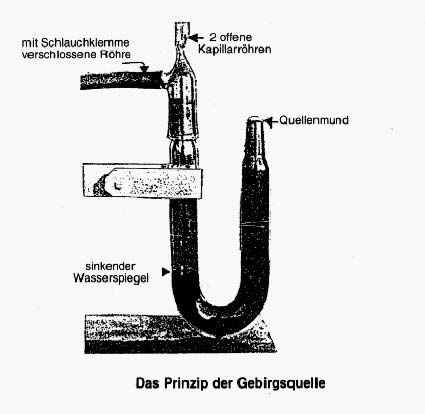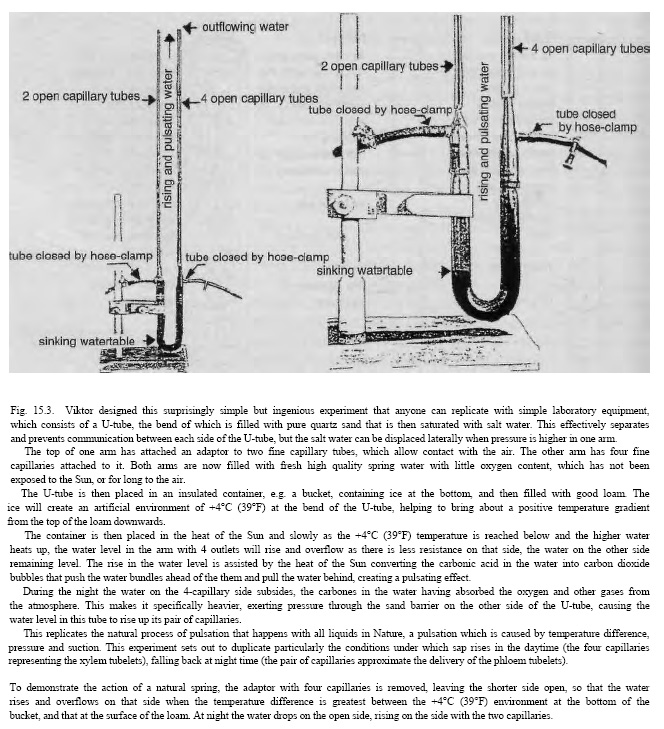An Experiment
A small and unassuming experiment reveals a great law.
Take a vessel, fill it with sand, insulate the sides and the base from the effects of external temperature. By placing ice at the bottom of the vessel a temperature of +4°C (39.2°F) can be produced artificially - conditions will be created which are to be found inside the Earth.
Into the vessel thus prepared, insert a U-shaped glass tube into which is placed a quantity of pure quartz sand, which is almost chemically neutral. This sand should then be infused with saltwater. Both legs of the U-tube should then be filled with good water, enriched with absorbed and dissolved carbonous matter which has not been exposed to sunlight.
On the open ends of the U-tube place two glass caps, onto one of which are braised two capillary tubes, and onto the other four capillary tubes. This must be very carefully done to ensure that the openings of the capillary tubes are not blocked in the process of being fused to the U-tube.
When this has been done, expose the surface of the sand bed to the Sun's rays. When the water reaches the anomaly point of +4°C (due to the ice-cooled sand bed at the bottom of the U-tube), and when the surface of the vessel reaches a temperature of about +20°C (68°F) as a result of the Sun's heat, then the water, known to attain its greatest density and weight at +4°C (39.2°F), begins to lose its equilibrium and rises up one leg of the U-tube if both legs of the U-tube are connected to the capillaries with suitably tapered unions.
If air is now entrained through the inlets on either side of the U-tube, as occurs for example with boreholes or wells driven into the Earth, the higher-rising water-column on one side sinks, and the water levels itself out in both U-tube legs, in accordance with the Law of Communication. If both side-inlets are once more closed to atmospheric influence and the cold of the surroundings again begins to take effect, then after a while the water will once again begin to rise.
Why does the water subside as soon as it comes in contact with the entrained atmosphere?
If both openings are once more closed to atmospheric influence and the cold of the surroundings again begins to take effect, then after a while the water will once again begin to rise.
At night the process is reversed. In the capillaries in which the water previously rose a state of rest exists due to the effect of light and heat, whereas in the other capillaries the water now rises. The rising product of the alternating processes of equalisation exactly represents the different phenomena of night and day.
This simple experiment shows us why the substances that rise in plants during the day are different from those which rise during the night, and why the various types of blood circulate in our veins. Moreover it reveals many things to us about the secret of Life and its coming into being, which can only be achieved through contrasting conditions of heat and cold.
At the same time, this experiment also demonstrates the stupidity of the purely mechanical and thoroughly one-sided activities we call work, and how little we are aware of the underlying conformities with the laws of Nature and their processes. It would be beyond the scope of the matter at hand to explain all the necessary details and preconditions for the success of this experiment.
The development of all Life and the associated formation of structures is not merely a process to do with heat, as is assumed today, but also to do with cold - for Life can only be born out of differences. It is not possible to describe the subtle differences in the processes of decomposition and transformation that take place during growth, or which are necessary to transform such energy-bodies as coal, metals, minerals and elements and their compounds. It would likewise take up too much space to elaborate all the ways in which it is possible to accumulate dissociated energy-particles and coalesce them into an immaterial body.
One thing can be stated however: our learned scientists should quietly give up all ideas of violently splitting the atom in order to obtain free energy from the matter thus released. These attempts are both purposeless and absurd. Nature shows us in every blade of grass how it can be more simply and intelligently achieved.
Pictures from various books:



